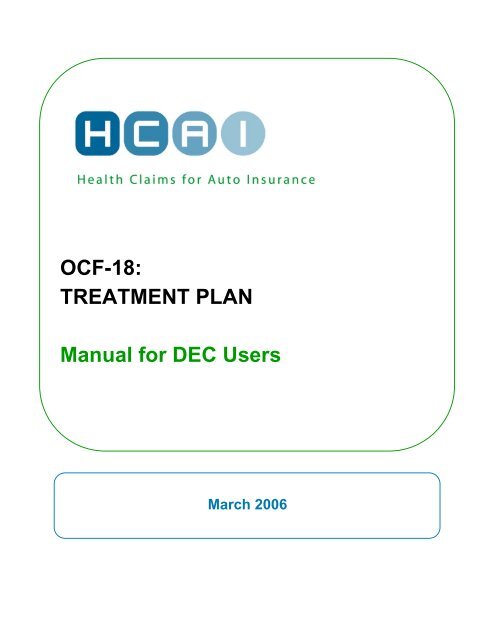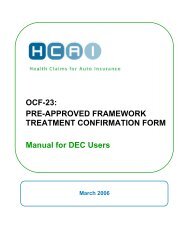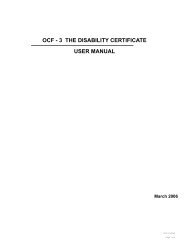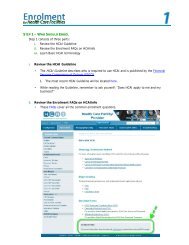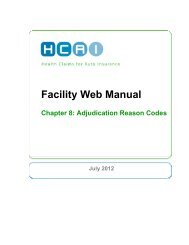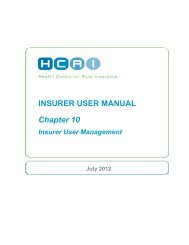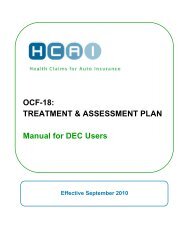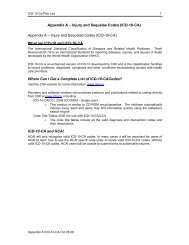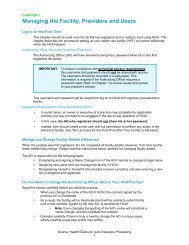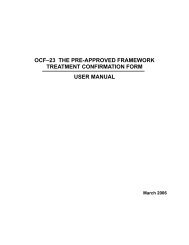Injury and Sequelae Codes (ICD-10-CA) - HCAI
Injury and Sequelae Codes (ICD-10-CA) - HCAI
Injury and Sequelae Codes (ICD-10-CA) - HCAI
You also want an ePaper? Increase the reach of your titles
YUMPU automatically turns print PDFs into web optimized ePapers that Google loves.
OCF-18:<br />
TREATMENT PLAN<br />
Manual for DEC Users<br />
March 2006
Document Change History<br />
Date Description of Change Reason<br />
20050214 Revised Signature of Health Practitioner &<br />
Applicant Signature, Repositioned Signature of<br />
Insurer<br />
20060301 Revised Further Information, Who completes<br />
form, Other Insurance Information, Signature of<br />
Health Practitioner & Regulated Health<br />
Professional <strong>and</strong> Health Providers<br />
Changes are underlined.<br />
Introduction<br />
Who should use this manual<br />
For consistency with revised OCF forms<br />
01/Dec/04<br />
Redirects users to H<strong>CA</strong>I website for<br />
further information <strong>and</strong> reflects inclusion<br />
of Social Worker as per revised SABS<br />
This User Manual is designed to assist both health care providers <strong>and</strong> automobile insurers in the completion of the OCF–<br />
18 Treatment Plan. Other manuals are available to assist in the completion of:<br />
OCF–3<br />
OCF–21<br />
OCF–22<br />
OCF–23<br />
OCF–24<br />
Disability Certificate<br />
Auto Insurance St<strong>and</strong>ard Invoice<br />
Application for Approval of an Assessment or Examination<br />
Pre-Approved Framework Treatment Confirmation Form<br />
Pre-Approved Framework Discharge & Status Report<br />
Facilities <strong>and</strong> health care providers dealing with victims of motor vehicle accidents are required to use these forms.<br />
Both rehabilitation health care providers <strong>and</strong> automobile insurers have dedicated a tremendous amount of time <strong>and</strong><br />
thought to the revision of the Treatment Plan <strong>and</strong> other forms. These forms will improve the accountability of all parties,<br />
streamline the process of delivering health care services to applicants, <strong>and</strong> enhance communication between insurers <strong>and</strong><br />
health care professionals.<br />
The forms are designed to facilitate a clear underst<strong>and</strong>ing of the interactions amongst an injured motorist, a health care<br />
professional <strong>and</strong> an insurer through the use of common terms <strong>and</strong> language. All forms use the national coding st<strong>and</strong>ards,<br />
the International Statistical Classification of Diseases <strong>and</strong> Related Health Problems, Tenth Revision, Canada (<strong>ICD</strong>-<strong>10</strong>-<br />
<strong>CA</strong>) 1 , to identify injuries <strong>and</strong> the Canadian Classification of Health Interventions (CCI) 1 to classify health care services <strong>and</strong><br />
procedures.<br />
What is in this manual<br />
The manual provides detailed instructions for completion of the fields in the order in which they appear on the forms. The<br />
appendices include tables of st<strong>and</strong>ardized codes <strong>and</strong> descriptions for the various codified fields used on the forms.<br />
Where can I get more information<br />
The manual will be updated from time to time. The latest updates to the manual can be downloaded from the website<br />
www.hcaiinfo.ca under Auto Insurance Resources>Statutory Accident Benefits>Claims Forms.<br />
Contact your professional association for any questions relating to coding of injuries, interventions, health care services<br />
<strong>and</strong> guidelines as they relate to your specific practice.<br />
1 <strong>ICD</strong>-<strong>10</strong>-<strong>CA</strong> <strong>and</strong> CCI are copyright products of the Canadian Institute for Health Information (CIHI) <strong>and</strong> may not be changed without the Institute’s express<br />
permission<br />
2
Samples of Completed Sections of the Forms<br />
The samples <strong>and</strong> fees used throughout the manual are entirely fictitious. They are designed to assist you in<br />
underst<strong>and</strong>ing how to use <strong>and</strong> complete the forms.<br />
3
OCF-18 - Treatment Plan<br />
Background<br />
Except in the case of treatment provided under a Pre-approved Framework, health professionals must fully complete the<br />
Treatment Plan, OCF-18, in order to have a plan of treatment approved <strong>and</strong> funded. The insurer may waive this<br />
requirement.<br />
Purpose:<br />
<br />
<br />
<br />
<br />
<br />
<br />
To describe the cause <strong>and</strong> nature of injuries that are a direct result of the motor vehicle accident.<br />
To identify activities limited by the injury <strong>and</strong> sequelae.<br />
To identify the treatment plan goals, how progress on the goals will be measured, <strong>and</strong> any barriers to recovery.<br />
To identify any prior <strong>and</strong> concurrent conditions that could affect the claimant’s response to the treatment.<br />
To describe the treatment proposed <strong>and</strong> estimated cost.<br />
To increase accountability of the claimant, health care provider(s) <strong>and</strong> insurer.<br />
This form may not be materially altered; in other words, the document cannot be changed in any manner. If this<br />
document is materially altered, it may be considered incomplete <strong>and</strong> the insurer may not accept the form.<br />
When is an OCF-18 required<br />
Unless waived by the insurer or in the case of a Pre-approved Framework, a Treatment Plan must be completed before<br />
the reimbursement of medical <strong>and</strong> rehabilitation benefits.<br />
Insurers may choose to agree to pay medical <strong>and</strong> rehabilitation benefits without requesting a treatment plan. Insurers<br />
must provide written confirmation of what they will pay for without a treatment plan. They may later request a treatment<br />
plan for future treatment.<br />
Who completes this form<br />
The applicant or a substitute decision maker completes Part 1 <strong>and</strong> 2 <strong>and</strong> signs Part 14. The Substitute Decisions Act<br />
states that a substitute decision maker is a person with power of attorney for personal care or a court appointed guardian.<br />
Any regulated health professional or social worker may fill out Part 3 <strong>and</strong> Parts 6 to 12.<br />
A health practitioner (i.e., chiropractor, dentist, nurse practitioner, occupational therapist, optometrist, physician,<br />
physiotherapist, psychologist or speech-language pathologist) must sign Part 5. In doing so, the health practitioner<br />
is stating that the treatment set out in the plan is reasonable <strong>and</strong> necessary for the injuries set out in Part 7.<br />
The insurer completes Part 13 <strong>and</strong> returns a copy of the page to the health practitioner indicated in Part 5 <strong>and</strong> the<br />
applicant from Part 1.<br />
It is important to ensure, where possible, that if more than one health care professional at the same facility is participating<br />
in the Treatment Plan, only one treatment plan is submitted per facility for the period of the Treatment Plan. This will allow<br />
for a single comprehensive plan, allowing for continuity of care among all health care providers.<br />
Fee<br />
The fee for completion of this form should be billed directly to the insurer. It is not a benefit of the Ministry of Health <strong>and</strong><br />
Long-Term Care.<br />
It is a conflict of interest to receive any payment or benefit in addition to the insurer’s fee for completion of the form.<br />
4
Return this form to:<br />
Enter the name <strong>and</strong> mailing address of the Insurance Company responsible for h<strong>and</strong>ling the claim.<br />
Claim Identifiers<br />
The applicant must indicate the claim number if known, the policy number, <strong>and</strong> the date of the accident. The claim<br />
number <strong>and</strong> policy number can be obtained from the insurance adjuster. The policy number is also available on the Motor<br />
Vehicle Liability Insurance Card (pink slip) received with the policy declaration.<br />
The Claim Number <strong>and</strong> Policy Number may be the same.<br />
The accident date must be completed. Forms will not be processed without it. If a patient has overlapping injuries<br />
from more than one accident, use the date of the accident that is most relevant to the injuries being treated.<br />
Treatment Plan Number<br />
Enter a number indicating how many times you have completed a Treatment Plan for this applicant <strong>and</strong> this motor vehicle<br />
accident.<br />
Part 1<br />
Applicant Information<br />
To be completed by the Applicant.<br />
Part 2<br />
Insurance Company Information<br />
To be completed by the Applicant.<br />
5
Part 3<br />
Other Insurance Information<br />
Other insurance may be available from the Ministry of Health <strong>and</strong> Long-Term Care (MOH) or through an applicant’s<br />
personal, spousal, or parental Extended Health Care plan to cover or partially cover some or all of the goods <strong>and</strong> services<br />
listed. This section is to be completed by the health professional or social worker responsible for plan preparation <strong>and</strong><br />
supervision, with information from the applicant.<br />
Indicate if the treatment you will be providing is covered by the MOH.<br />
Determine other insurance coverage that the applicant might have. Space is available for two other insurers in the event<br />
that the applicant is covered by more than one policy (e.g., if both the applicant <strong>and</strong> the applicant’s partner or legal<br />
guardian have extended health benefits).<br />
The auto insurer is not liable for any costs that are payable by any other insurer.<br />
Part 4<br />
Conflict of Interest Definition<br />
Before proceeding to the rest of the form, determine if you have a conflict of interest relating to this treatment plan.<br />
6
Part 5<br />
Signature of Health Practitioner<br />
According to the Statutory Accident Benefits Schedule, health practitioners are chiropractors, dentists, nurse practitioners,<br />
occupational therapists, optometrists, physicians, physiotherapists, psychologists <strong>and</strong> speech-language pathologists.<br />
Only these professionals may sign Part 5, <strong>and</strong> the signature is required before the Treatment Plan can be submitted to the<br />
insurer. The inclusion of a revised statement of underst<strong>and</strong>ing identifies for the Health Practitioner the range of specific<br />
uses that will be made of information related to providing services to injured auto insurance claimants.<br />
Before signing Part 5, confirm that the applicant <strong>and</strong> the regulated health professional or social worker in Part 6 have<br />
reviewed the Treatment Plan together to make certain that the requirements for informed consent have been met.<br />
7
Part 6<br />
Signature of Regulated Health Professional<br />
If you completed Part 5, <strong>and</strong> are also the regulated health professional responsible for the preparation <strong>and</strong> supervision of<br />
the treatment plan, you do not need to complete Part 6. Simply check the box as indicated <strong>and</strong> continue to Part 7. This<br />
section has been revised to reflect the inclusion of social worker.<br />
Unregulated providers may not sign this section.<br />
Refer to Appendix E for a complete list of regulated health professions.<br />
Part 7<br />
<strong>Injury</strong> <strong>and</strong> <strong>Sequelae</strong> Information<br />
List the injuries <strong>and</strong> sequelae that are a direct result of the automobile accident. Provide a brief description of the injury<br />
<strong>and</strong> the corresponding injury code (<strong>ICD</strong>-<strong>10</strong>-<strong>CA</strong> code). Up to six injuries/sequelae may be entered including the description<br />
<strong>and</strong> a valid <strong>ICD</strong>-<strong>10</strong>-<strong>CA</strong> code.<br />
List the most significant injury first; describe the patient’s most significant condition that is directly related to the<br />
automobile accident <strong>and</strong> that requires health care services. In a case where multiple injuries may be classified as the<br />
most significant, list the injury requiring the most services.<br />
It is anticipated that, with the use of “multiple injury” codes (see Appendix A) there will likely not be more than six<br />
injury/sequelae codes needed. However, should more space be required, you may attach an additional page.<br />
Refer to Appendix A for further information on <strong>ICD</strong>-<strong>10</strong>-<strong>CA</strong>.<br />
8
Refer any questions regarding injury coding to your provider association or access the website at www.hcaiinfo.ca under<br />
Auto Insurance Resources>Statutory Accident Benefits><strong>Codes</strong> <strong>and</strong> Appendices.<br />
Part 8<br />
Prior <strong>and</strong> Concurrent Conditions<br />
The information provided in this section helps the insurer to better underst<strong>and</strong> the applicant’s pre-accident status <strong>and</strong><br />
informs the insurer of any pre-existing condition(s) that may affect the applicant’s response to treatment. Provide relevant<br />
information to the best of your knowledge <strong>and</strong> based on information from the applicant. A response of “Unknown” may<br />
prompt a request for further clarification from the insurer. Additional sheets may be attached if necessary.<br />
In Part 8 c), if you are proposing treatment for a condition for which there is a Pre-approved Framework, indicate why the<br />
Pre-approved Framework does not apply.<br />
Part 9<br />
Activity Limitations<br />
The responses are based on your current knowledge <strong>and</strong> information provided by the applicant. If any of the responses to<br />
the questions in section a) are “yes”, provide a brief description of the activity limitations the applicant is experiencing.<br />
A response of “no” in section c) requires further explanation <strong>and</strong> may require contacting the employer, but is not intended<br />
to signify the need for a job site assessment.<br />
9
Part <strong>10</strong><br />
Goals, Outcome Evaluation Methods <strong>and</strong> Barriers to Recovery<br />
(Partial Screen Print)<br />
This section is intended to outline the goals of treatment <strong>and</strong> how the health care provider will evaluate treatment<br />
progress. It also provides additional information around other barriers to recovery that are not indicated as a prior or<br />
concurrent condition, <strong>and</strong> informs the insurer of any concurrent treatment being provided to the patient.<br />
In Part <strong>10</strong> e), indicate if you are aware of any applicable guidelines for this patient's condition. These may be clinical<br />
guidelines, Superintendent's guidelines, or other less formal guidelines.<br />
Failure to list a guideline cannot in itself result in the denial of the Treatment Plan.<br />
Part 11<br />
Health Providers<br />
Health Providers <strong>and</strong> Social Workers are assigned an upper case alphabetic letter (i.e., the Provider Reference). The<br />
Provider Reference is used to cross-reference information in Part 12 of the Treatment Plan <strong>and</strong> the Automobile Insurance<br />
St<strong>and</strong>ard Invoice.<br />
Assign a Provider Type code for each of the health professionals <strong>and</strong> social workers rendering services or prescribing<br />
goods.<br />
Refer to Appendix E for a complete list of Provider Type codes.<br />
If you are a regulated health professional, provide your college registration number <strong>and</strong> leave the AISI number blank. If<br />
you are an unregulated provider, you can obtain an AISI number by registering at www.hcaiinfo.ca.<br />
NB Future implementation of the H<strong>CA</strong>I system may eliminate the need for an AISI number.<br />
If appropriate, enter the hourly billing rate for each of the providers listed. If you will not be billing for the proposed services<br />
using an hourly rate, enter N/A.<br />
<strong>10</strong>
Part 12<br />
Proposed Goods <strong>and</strong> Treatment Services<br />
Refer to Appendix C for additional examples of Part 12 Proposed Goods <strong>and</strong> Treatment Services.<br />
Goods/Service Reference (G/S)<br />
Assign a G/S reference number to each good or service you will be providing to the applicant. Remember to use the<br />
same G/S reference number from the Treatment Plan when completing Version A of the Automobile Insurance<br />
St<strong>and</strong>ard Invoice (OCF-21).<br />
Description<br />
Enter a description of the good or service provided.<br />
Code <strong>and</strong> Attributes<br />
For those services representing a diagnostic, therapeutic, or health care support intervention, enter a valid CCI code <strong>and</strong><br />
attribute if required.<br />
Refer to Appendix B for a list of CCI codes <strong>and</strong> corresponding Attribute <strong>Codes</strong><br />
For goods, administration <strong>and</strong> other codes (GAP) not included in the CCI code set, enter a valid GAP code.<br />
Refer to Appendix C for a list of valid GAP codes.<br />
Refer any questions regarding goods <strong>and</strong> service coding to your provider association or access the website at<br />
www.hcaiinfo.ca.<br />
11
Provider Reference<br />
Enter the Provider Reference code of the health professional or social worker who will render the service or is prescribing<br />
the good (from Part 11).<br />
When a service is to be provided by more than one health care professional or social worker, enter all Provider Reference<br />
codes (separated by commas).<br />
Estimate / Day<br />
In the three columns under this heading, you are to enter the elements of information that are needed to calculate the<br />
estimated total cost of each good <strong>and</strong> service that will be delivered during each day of anticipated treatment.<br />
<br />
<br />
<br />
First, you need to enter the total quantity of the good or service that will be delivered during each visit or treatment<br />
day; this will appear as a number (e.g., 75, 6, 52…).<br />
Second, identify the unit of measure (e.g., hours of service, number of pages, kilometres of travel) for the quantity<br />
of service you are proposing to deliver each treatment day.<br />
Third, report the cost per service.<br />
Refer to Appendix F for valid Unit Measure <strong>Codes</strong> <strong>and</strong> a Conversion Table to convert minutes to hours.<br />
Projected Total Count<br />
For each Good/Service Reference line, enter the total number of the good(s) or service(s) anticipated over the course of<br />
this treatment plan.<br />
Projected Total Cost<br />
For each Good/Service Reference line, enter the total cost of the good(s) or service(s) anticipated over the course of this<br />
treatment plan. It is calculated by multiplying cost by projected total count.<br />
Sub-Total Count<br />
The sub-total of Total Count is the sum of all counts of all goods <strong>and</strong> services to be rendered under this treatment plan. It<br />
is calculated by summing the Projected Total Count column.<br />
Sub-Total Cost<br />
The sub-total of Total Cost is the sum of all costs for all goods <strong>and</strong> services to be rendered under this treatment plan. It is<br />
calculated by summing the Projected Total Cost column.<br />
Totals<br />
In the Totals section:<br />
<br />
<br />
<br />
<br />
<br />
<br />
Sub-Total is the sum of the cost of all goods <strong>and</strong> services included in this treatment plan.<br />
MOH is the sum of all Ministry of Health <strong>and</strong> Long-Term Care amounts that are payable to you for any of the<br />
goods <strong>and</strong> services listed above; this is subtracted from the sub-total.<br />
Other Insurer 1 + 2 is the sum of all amounts payable to you from other insurers; this is also subtracted from<br />
the sub-total.<br />
GST is the total GST for all goods <strong>and</strong> services listed above.<br />
PST is the total PST for all goods <strong>and</strong> services listed above.<br />
Auto Insurer Total is the sum of all amounts in this section.<br />
12
Part 13<br />
Signature of Insurer<br />
The insurer will complete Part 13 <strong>and</strong> return page 5 to the applicant <strong>and</strong> the health practitioner indicated in Part 5. The<br />
health practitioner should contact each of the health professionals <strong>and</strong> social workers listed in Part 11 <strong>and</strong> provide details<br />
of the services <strong>and</strong> other charges that have been approved <strong>and</strong> are payable under this Treatment Plan.<br />
If the insurer partially approves or does not approve the treatment, they must provide an explanation as to why the<br />
treatment plan has been declined.<br />
Part 14<br />
Signature of Applicant<br />
After you have reviewed the treatment plan with the applicant, the applicant or the applicant’s Substitute Decision Maker,<br />
as defined in the Substitute Decisions Act, must sign here. The insurer may elect to waive the requirement of the<br />
applicant signature, but this must be ascertained in advance.<br />
The consent for the use of information has been revised to reflect the current privacy legislation <strong>and</strong> other legislation with<br />
which insurers must comply. Insurers are responsible for ensuring that claimants underst<strong>and</strong> these conditions when<br />
initiating a claim through the submission of an OCF-1.<br />
Should the claimant require more information about the consent <strong>and</strong> their obligations, please refer him/her to their<br />
insurance claims adjuster.<br />
13


